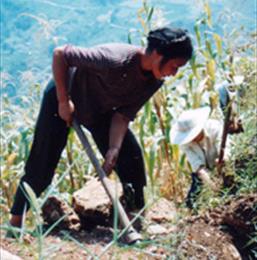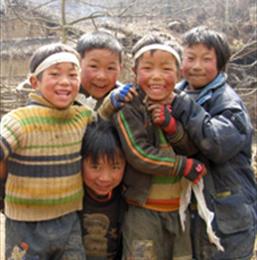Moduo Village Hamlet 2-7 Water Supply Project
Project Evaluation March 2000
Introduction
The purpose of this report is to evaluate the project. The full DORS contribution has been made towards this drinking water project. The outline aim of the project was to supply drinking water to all households of Moduo Village Hamlet 2-7 through PVC piping, supplying water to 855 people. The new gravity flow supply uses 7 different mountain stream sources. Water is now piped to all households in this particularly remote and poor village.
DORS received a request via Mr Deng, Hamlet Leader of Moduo Hamlet 1, on behalf of Moduo Village hamlet 2-9, to consider assisting with their drinking water supply. DORS previously assisted Moduo Hamlet 1 with their supply, with Mr Deng managing the project. Mr Deng was so grateful that he volunteered to assist with project management in this remote location, also fitting well with DORS aim of maximum local participation. The MRDF funding was used for hamlets 2-7. DORS propose to continue with hamlets 8 and 9 at a later date.
Background
Moduo hamlets 2-7 are situated on a gently sloping plain high above a steep ravine on the Dadu River in the SE of Hanyuan County. The village is approximately 2,000m above sea level. There is a road to the village that is impassable in the winter snow. The drive from Hanyuan’s county town, Fulin, is 2-3 hours. The villagers survive by farming, the main crops are staples including maize and potatoes. Most households engage in animal husbandry, raising pigs for their own consumption and cows, goats or horses. The preferred grain crop, rice cannot be grown due to the high altitude in Moduo.
The village is populated by both the majority Han and the Yi nationality ethnic minority peoples found in SW Sichuan.
Pre-project Water Situation
All the hamlets were severely short of drinking water. In the winter months water was insufficient to meet household and animal husbandry requirements. Water was piped in small plastic pipes to the households, but the water source was inadequate, piping quality was poor and much water was lost along the route from the mountain spring source to the houses. People were collecting water from wells and tanks some distance from their homes in the winter months.
Design
There was a piped supply in place that was not functioning adequately. The new design replaced leaking reservoir tanks above the hamlets, and new sedimentation tanks were constructed at source to reduce turbidity. Hanyuan County Water Conservancy Bureau were consulted on several occasions to approve system design. Mr Deng worked closely with villagers to decide on the piping layout.
UPVC piping was laid from the water source tanks to the reservoir tanks. From the reservoir tanks a network of piping was laid to the households. In all, seven separate water supply systems were installed using 12,680m piping.
Management
The water supply project was managed jointly by Mr Deng of Moduo Village and DORS. An initial visit was made to the village to assess the pre-project situation. There were a variety of problems being experienced by the different parts of the village. Mr Deng held meetings with village leaders and selected one person as responsible for each piping line. The villagers provided the information on the number of households and their location, and the number of people in each household. Mr Deng worked with the villagers to identify the poorest households for whom DORS agreed to supply taps and cement for water chests. The piping lines were measured and piping sizes calculated.
DORS and Mr Deng signed a contract in September 1999 and the funds were disbursed as agreed, upon completion of each stage of the project. All project receipts were submitted to DORS, and any changes to the agreed design were approved by DORS before commencement.
DORS made several progress visits to the village. Villagers provided the labour free of charge, and Mr Deng organised the purchase and transportation of materials and project implementation.
As the project was nearing completion meetings were held in each hamlet on future maintenance of the supply, villagers attended and each user group selected a person responsible for maintenance, and outlined their responsibilities (some of these were based on pre-existing system for managing the scarce water).
Project Finance
The total cost of the Moduo Drinking Water Supply hamlets 2-7 was 45,596 RMB, or £3470. The total project funds were provided as part of a block grant from MRDF, UK in April 1999.
Receipts were provided to DORS for all purchases and were in order. See Appendix 1 for breakdown of project expenditure.
Benefits
All the 855 people in the hamlets have benefited from the supply. Water is now piped to each household. Most have cement storage tanks, and taps attached to the piping.
Women and children will particularly benefit from the new supply as they are the primary water carriers in the winter months. There are health benefits as the piped water is more sanitary than the pond water some households had to use in winter, and a more abundant supply means sufficient water for washing, food preparation. In addition, water is more convenient for raising additional livestock for sale, thus improving household income.
Problems Encountered
There were several minor problems encountered during the implementation of this project.
Some cement was provided for the poorest households to ensure they built household water storage chests. Most households already had some form of water storage facility in the house or courtyard, so DORS did not wish to allocate to all households. Mr Deng informed us which households were particularly poor at the beginning of the project, and we used that list as a basis for deciding which households were allocated cement for chests and taps. However, some villagers objected to the households selected and wanted to be included in the list. DORS gave Mr Deng discretion to make decision on which additional households to include.
There is some misunderstanding about hydrological principles, with villagers in particular thinking that the bigger the water tank the better, and the bigger the pipe the more water they will get. Mr Deng explained these principles as best he could, but some villagers still disagreed about the piping sizes chosen. It is important in future project to explain these principles as fully as possible.
Some of the piping purchased by weight was of a different weight per meter than was estimated, so the prices had to be amended, and additional funds given.
Maintenance and Sustainability
Factors that ensure high levels of sustainability in community water supply projects include: local involvement in design, beneficiaries participating in the construction, use of local materials for ease of repair, high level of local ownership of the project, beneficiaries making a contribution to the implementation costs, and a clearly defined locally initiated maintenance structure.
With reference to this project, Mr Deng managed the project, design was based on the original design with alterations initiated by the users. Villagers provided labour towards the project, and all materials were locally available. Maintenance plans have been devised for each separate supply and a local person is responsible for maintenance, different locally drawn up contracts for responsibility. Therefore, a maintenance structure is set up and the project should be sustainable in the longer-term.
Evaluation
The drinking water supply took 4 months to complete and was finished in December 1999. The cost per person was £4.
A preliminary evaluation visit was made in January 2000 and 32 households visited in the different parts of the village. The villagers showed their household taps and described how water use is much more convenient now than previously. See appendix for details of households visited. Water shortages are usually the most severe in winter (Jan/ Feb), but with the installation of the new supply, all households have access to drinking water all year round. The supply still needs to be carefully managed, as the water sources are not abundant in winter.
Mr Deng managed the project to a very high standard, providing receipts to DORS and informing us of project progress on a regular basis.
Summary
Overall the project has been successful. Mr Deng managed the project well, kept DORS informed of minor changes to the project plans, and provided full details of expenditure. The main advantages of the project are that the severe winter and spring water shortages have been reduced and that the villagers now have a clean and sanitary water supply. The water is available conveniently located in their homes and courtyards.
Next Review
The project will be evaluated again in one year’s time to check it is still working well.
Appendix 1 - Moduo Drinking Water Supply (Project 991)
Table of DORS Project Payments
|
Date |
Amount RMB |
Budget code |
|
6th Sept 1999 |
30,000 |
Materials |
|
6th Sept |
600 |
Travel for Mr Deng |
|
26th Oct |
6155 |
Materials Extra piping price and length |
|
23 Nov |
2599 |
Materials extra piping and connectors |
|
20 Dec |
-307.9 |
Returned funds (unused) |
|
4 Jan 2000 |
-100 |
Returned funds (unused) |
|
15 Feb |
1650 |
Management and travel fee to Mr Deng |
|
18 Feb |
5000 |
DORS monitoring and evaluation |
Summary Table of Project Expenditures
|
Materials |
Totals (RMB) |
|
Piping 12,680m |
30,861.6 |
|
Cement |
3,817 |
|
Valves and connectors |
2,350 |
|
Transport |
1,457.7 |
|
Other |
72 |
|
Management fee incl. transport expenses |
2250 |
|
Monitoring and Evaluation |
5000 |
|
Total |
45,808.3 |


